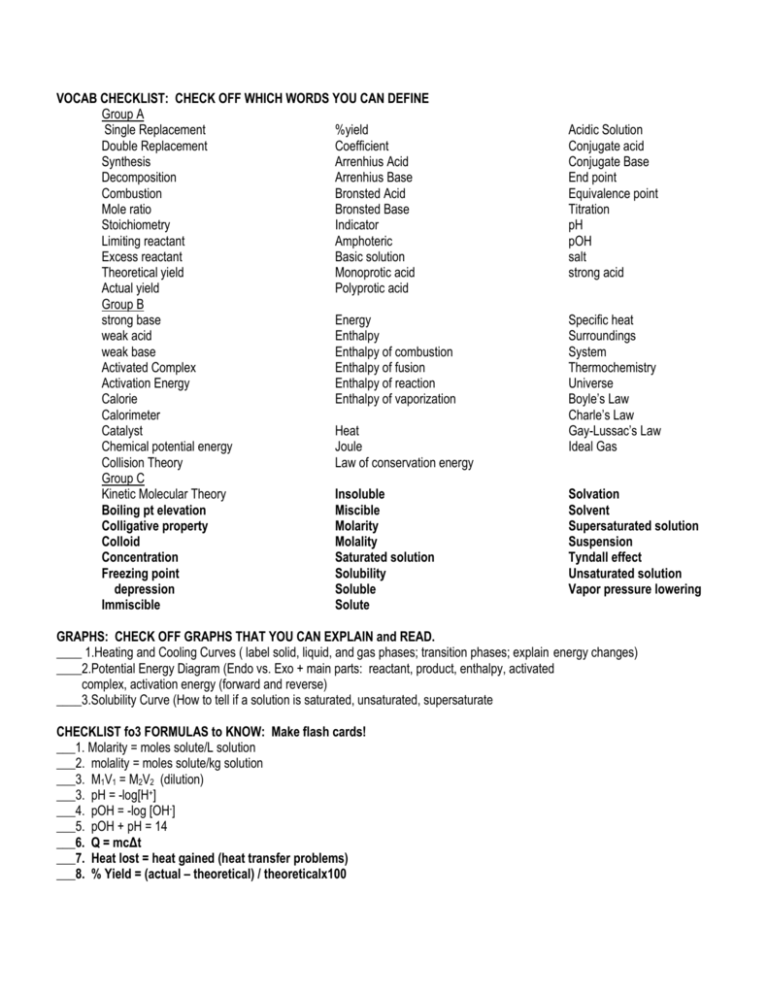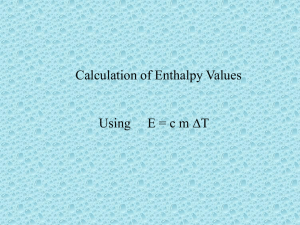review spring semester2 CP
advertisement

VOCAB CHECKLIST: CHECK OFF WHICH WORDS YOU CAN DEFINE Group A Single Replacement %yield Double Replacement Coefficient Synthesis Arrenhius Acid Decomposition Arrenhius Base Combustion Bronsted Acid Mole ratio Bronsted Base Stoichiometry Indicator Limiting reactant Amphoteric Excess reactant Basic solution Theoretical yield Monoprotic acid Actual yield Polyprotic acid Group B strong base Energy weak acid Enthalpy weak base Enthalpy of combustion Activated Complex Enthalpy of fusion Activation Energy Enthalpy of reaction Calorie Enthalpy of vaporization Calorimeter Catalyst Heat Chemical potential energy Joule Collision Theory Law of conservation energy Group C Kinetic Molecular Theory Insoluble Boiling pt elevation Miscible Colligative property Molarity Colloid Molality Concentration Saturated solution Freezing point Solubility depression Soluble Immiscible Solute Acidic Solution Conjugate acid Conjugate Base End point Equivalence point Titration pH pOH salt strong acid Specific heat Surroundings System Thermochemistry Universe Boyle’s Law Charle’s Law Gay-Lussac’s Law Ideal Gas Solvation Solvent Supersaturated solution Suspension Tyndall effect Unsaturated solution Vapor pressure lowering GRAPHS: CHECK OFF GRAPHS THAT YOU CAN EXPLAIN and READ. ____ 1.Heating and Cooling Curves ( label solid, liquid, and gas phases; transition phases; explain energy changes) ____2.Potential Energy Diagram (Endo vs. Exo + main parts: reactant, product, enthalpy, activated complex, activation energy (forward and reverse) ____3.Solubility Curve (How to tell if a solution is saturated, unsaturated, supersaturate CHECKLIST fo3 FORMULAS to KNOW: Make flash cards! ___1. Molarity = moles solute/L solution ___2. molality = moles solute/kg solution ___3. M1V1 = M2V2 (dilution) ___3. pH = -log[H+] ___4. pOH = -log [OH-] ___5. pOH + pH = 14 ___6. Q = mcΔt ___7. Heat lost = heat gained (heat transfer problems) ___8. % Yield = (actual – theoretical) / theoreticalx100 Practice Problems I. If the statement is true, write T. If it is false, write F and change the underlined word to make it true. 1. Two polar liquids will most likely be immiscible when mixed together. 2. Shaking and stirring decreases the rate of salvation. 3 A dilute solution contains a small amount of solute relative to the solvent. 4. Molar solutions are calculated and expressed in grams per liter. 5. The boiling point elevation is the difference between a solute’s boiling point and a pure solvent’s boiling point. 6. A 1 m solution of a nonelectrolytes solute will have a lesser effect on the colligative properties of its solution than than a 1m solution of an electrolyte will have on the colligative properties of its solutions. 7. Boiling point depression is the temperature difference between a solution’s and a pure solvent’s boiling point. 8. Colloids are heterogeneous mixtures that contain particles between 1 nm and 1000 nm in diameter. 9. Enthalpy changes for exothermic reactions are always negative. 10. A pH greater than 7 indicates a standard solution. 11. If the pH of a solution is 10, its pOH is 4. 12. In a neutralization reaction, an acid and a base react to produce an oxide and water. 13. Gay Lussac’s law states that the volume and Kelvin temperature of a contained gas are directly proportional if pressure is constant. II. Choose the correct answer for the following questions. 14. After adding a small crystal of copper (II) sulftate to an aqueous solution a slarge amount of copper sulfate precipitate. Which of the following describes the original solutions? a. unsaturated b. viscous c. saturated d. supersaturated 15. The ability to be separated by paper filtration is a characteristic of which mixture? a. solution b. colloids and solution c. suspension d. colloids 16. Which of the following will scatter light? a. salt water b. ice tea c. fog d. koolaid 17. Energy flow from a warmer to a cooler object is a. Specific heat b. enthalpy c. heat d. activation energy 18. An insulated device for measuring the heat absorbed or released during a chemical or physical process is called a.enthalpy of reaction b . joule c. valve d. calorimeter 19. Energy needed to melt one mole of a solid is called a. molar enthalpy of fusion b. enthalpy of reaction c. molar enthalpy of vaporization d. enthalpy of combustion 20. ________________ are the products of a neutralization reaction between a strong acid and a strong base. a. salt and water b. acid and base c. gas and water d. hydrogen ions and hydroxide ions 21. If the pressure of a gas increases while the temperature remains the same, what happens to the volume? a. it decreases b. it increases c. it stays the same 22. What is the relationship between temperature and volume at constant pressure? a. indirect b. direct d. no relationship III. Fill in the blank 23. .The solvation of sodium chloride in water occurs because the Na has a ______ charge that attract to the _________ in the water and the Cl has a ____ charge that attracts to the ___________ atom in water. . 24. 25. 26. 27. 28. Compound A is __________________ and compound B is ____________. I know this because _________________________________________________. The SI unit for heat and energy is ____________________. In a calorimeter, the water is the ______________________ and the reaction is the system. The two make up the _______________. In a reaction, activation energy is the amount of energy needed to ___________________________. The pOH of a solution is equal to the negative log of the ____________ion concentration combined 29. Process A is ___________________(endo/exo?) because it _______________ heat. 30. Process B is ______________ because it ________________ heat. A) Identify the following equations as Synthesis (s), Decomposition (D), Single Replacement (SR), or Double Replacement (DR) on the line to the left of the number. B) Balance the equation C) Write the word equation under the chemical equation. _____1. N2 + H2 NH3 ______________________________________________________________________________________ _____2. CaCO3 CaO + O2 ______________________________________________________________________________________ _____3. Se + O2 SeO3 ______________________________________________________________________________________ _____4. Sr(NO3)2 + K2 SO4 KNO3 + SrSO4 ______________________________________________________________________________________ _____5. C2H4 + O2 CO2 + H2O _____________________________________________________________________________________ _____6. Cu + HCl CuCl2 + H2 _____________________________________________________________________________________ IV: Problem solving: 31. The solubility of potassium dihydrogen phosphate is 25g/100g at 25 C. What is the molality of this solution? 32. An exothermic process releases 10,570 Calories. Convert this to kJ. 33. How much heat has been absorbed by 6500 g of water when its temperature changes from 24.0 C to 28.0 C. Express in joules. How many food calories are supplied? 34A. The hydrogen ion concentration of a solution is 9.3x10-12. What is the pH of this solution? 34B. What is the hydroxide concentration of a solution that has a pH of 4.10? 35. The hydroxide ion concentration of a solution is 1.9x20-13. What is the pOH, pH and [H+]? 36. Write a balanced formula equation for the neutralization reaction between nitric acid and solid caclium hydroxide. 37. A 66.1mL sample of HCl is titrated to its end point with 33.3 mL of .350 M NaOH, What is the concentration of the acid? 38. A 18.5 mL sample of HCl is titrated to its end point with 25.7 mL of .150 M NaOH. What is the concentration of the acid? 39. The volume and amount of gas are constant in a tire. The initial pressure ande temperature are 1.92 atm and 293K. At what temperature will the gas in the tire have a pressure of 2.25 atm? 40. Calculate the volume occupied by 7 moles of I2 at STP. Moles and Stoichiometry 41. 42. 43. 44. 45. 46. 47. Calculate the number of molecules in 15.7 moles of carbon dioxide. Calculate the number of moles in 9.22x1023atoms of iron. Calculate the number of atoms in 3.5 moles of Zn. What is the mass of 6.89 moles of antimony? Determine the mass of 0.187 moles of CH4. Find the % of Aluminum in aluminum oxide. The composition of acetic acid is 40.00% carbon, 6,71 % hydrogen, and 53.29 % oxygen. Calculate the empirical formula for acetic acid. 48. The compound borazine consists of 40.29% boron, 7.51% hydrogen, and 52.20% nitrogen, and its molar mass is 80.50 g/mol. Find the molecular formula for borazine. Use the following equation to answer questions 49-52. 4HCl + O2 2 H2O + Cl2 49. What is the mole: mole ratio of H2O: H2CO3? 50. How many moles of chlorine gas are formed if 3.5 moles of HCl are used? 51. How many grams of water are made if 4 moles of HCl are used? 52. If moles of HCl are used and 4 moles of oxygen, what is the limiting and excess reagent? The following reaction occurs in plans undergoing photosynthesis: 6CO2 + 6H2O C6H12O6 + 6O2 53. How many liters of oxygen are made from 24 moles of CO2? 54. What is the % yield if the theoretical yield is 25 grams and the actual is 20 grams? Grams Of Compound x x 1mole MolarMass MolarMass 1mole 6.02 x1023 x 1mole # particles – molecules,formula units,ions,atoms Grams of element atomicMass x 1mole x MOLES x x 1mole 6.02 x10 23 xx 1mole atomicMass 22.4 L 1mole 1mole 22.4 L Liters Of Gas





